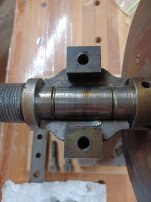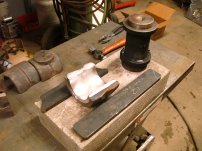Overland
Stainless
- Joined
- Nov 19, 2017
- Location
- Greenville, SC
Interesting project. Customer wants to replace bearings. Headstock too small to use pillow blocks, and bearing diameters are in necked down part of spindle. He's not concerned with overall shape of the bearings, just needs functionality.
Best idea I have is:
- start with a piece of rectangular section bronze, say 3" x 1.5".
- bolt 2 pieces together to form a square
- turn square section to round, avoiding bolts
- now I've got a split round blank
- turn bore to fit shaft
- mill flats on outside to fit in headstock
- possibly add shim material before bolt halves together for long term adjustment
I've not seen the job yet, just photos, so don't know how accurate headstock is for my idea to work.
I guess I could line bore the bearings in the headstock, but that wouldn't be easy with my equipment.
Another thought would be to turn the bore small, and scrape to ensure shaft fits nicely - not an easy task.
I have more pics if these are not clear to define problem.
Any other, better ideas ?
Thanks,
Bob
edit: the bolts to hold the two halves together would only be needed for machining. The holes would be left in the finished job.
Best idea I have is:
- start with a piece of rectangular section bronze, say 3" x 1.5".
- bolt 2 pieces together to form a square
- turn square section to round, avoiding bolts
- now I've got a split round blank
- turn bore to fit shaft
- mill flats on outside to fit in headstock
- possibly add shim material before bolt halves together for long term adjustment
I've not seen the job yet, just photos, so don't know how accurate headstock is for my idea to work.
I guess I could line bore the bearings in the headstock, but that wouldn't be easy with my equipment.
Another thought would be to turn the bore small, and scrape to ensure shaft fits nicely - not an easy task.
I have more pics if these are not clear to define problem.
Any other, better ideas ?
Thanks,
Bob
edit: the bolts to hold the two halves together would only be needed for machining. The holes would be left in the finished job.
Attachments
Last edited:









